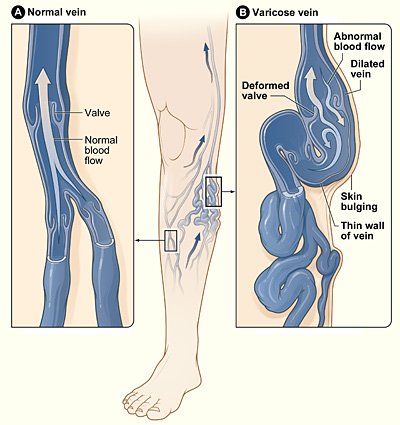What is chronic vein disease?
Chronic vein disease is disease of the veins (vessels that carry blood back to the heart) that usually affects the legs. Over time, the vein walls become weakened and stretched, causing the veins to bulge out and twist. Eventually the veins may become unable to pump enough blood back to the heart, causing blood to pool in the legs—a condition called Chronic Venous Insufficiency (CVI).
Chronic vein disease may cause no symptoms at first, but as it progresses it can produce swelling, pain, or ulcers on the legs that make walking and performing everyday tasks difficult.1 The harmful impact of CVI on quality of life is similar to that caused by heart failure, chronic lung disease, or arthritis.2,3
Varicose veins are the most common early sign of vein disease, affecting 1 in 3 adult women.4 Many women tend to think of varicose veins as only a cosmetic problem, but they may be a sign of serious vein disease that will get worse over time without proper treatment. It is estimated that 2.5 million people in the United States have CVI, and that 20% of these will develop ulcers caused by leg vein disease.5
What causes chronic vein disease?
The heart pumps blood to the lungs to pick up oxygen, then pumps the oxygen-rich blood to the tissues and organs of the body. After your body uses the oxygen, the oxygen-depleted blood needs to be returned to the heart so the cycle can begin again.
Blood is returned to the heart through blood vessels called veins. The veins contain valves that only allow blood to flow in one direction. When these valves do not close properly, gravity pulls the blood downwards and it pools in the legs.
Vein damage that results in chronic vein disease may be caused by:
- Damage to the vein valves caused by blood clots or deep vein thrombosis
- Weakened vein walls that cause the vein to stretch and twist, preventing the valves from closing completely
- Veins that are blocked by blood clots, preventing blood from flowing back to the heart
- Defective vein walls or missing vein valves that were present at birth (this is rare)
What are the symptoms of chronic vein disease?
Varicose veins are the most common early sign of vein disease. Varicose veins are leg veins that rise above the surface of the skin and may appear flesh colored, blue, or dark purple. They usually have a cord-like appearance and appear twisted or bulging. Common locations for varicose veins are the back of the calf and the inside of the legs. Varicose veins do not always cause serious symptoms, but if they are accompanied by pain, swelling, or wounds you should see a doctor for an evaluation.
Spider veins are similar to varicose veins except they are usually smaller and closer to the skin, and occur earlier in the disease. People with spider veins usually do not require treatment, but you should discuss them with your doctor so you can be monitored properly.

Illustration of varicose veins in the legs. A: In healthy veins, valves prevent the blood from flowing away from the heart. B: Varicose veins are stretched and twisted, preventing the valves from working properly and allowing blood to flow in the wrong direction.
As the disease gets worse, blood buildup in the legs caused by CVI can produce a variety of leg symptoms, including:
- Swelling in the legs, ankles, and feet
- Pain, aching, heaviness, or cramping in the legs (usually worse when standing, and improved when the legs are raised)
- An itching, tingling, or burning sensation
- Scaly, itchy rashes ( eczema) and thickening of the skin
- Slow or non-healing wounds on the legs (ulcers)
- Darkening of the skin on the legs (in severe cases)
Many options are available to treat varicose veins and the underlying vein disease, so make an appointment with your doctor immediately if you have any of the above symptoms.
Who is at risk for chronic vein disease?
Vein disease becomes more common as you age: while only 5% of women aged 18 to 24 have varicose veins, more than half of women older than 65 do. Less than 4% of women aged 35 to 44 have CVI, compared with more than 12% aged 55 to 64.6
Your risk of developing vein disease is also increased if you have certain characteristics or conditions, including:
- High blood pressure
- Obesity
- Lack of exercise (you should get 30 minutes a day at least 5 days a week)
- A family history of varicose veins
- You’ve had deep vein thrombosis (or blood clots in the veins)
- Pregnancy (the more times you have been pregnant, the more abnormal veins you are likely to develop)
- You have a job that requires prolonged standing or heavy lifting
- You have had a previous leg injury
While vein disease is generally thought to be more common in women than in men, a large survey of 1566 patients (55% were women) found that varicose veins and CVI were actually slightly more common in men than women after age was taken into account.6 Earlier studies that estimated women had more vein disease may have been biased because women were more likely to report unsightly varicose veins, and women tend to live longer and are therefore more likely to eventually develop vein problems.



